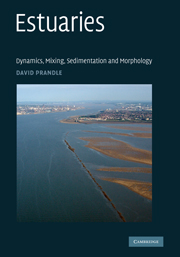Book contents
- Frontmatter
- Contents
- List of symbols
- 1 Introduction
- 2 Tidal dynamics
- 3 Currents
- 4 Saline intrusion
- 5 Sediment regimes
- 6 Synchronous estuaries: dynamics, saline intrusion and bathymetry
- 7 Synchronous estuaries: sediment trapping and sorting – stable morphology
- 8 Strategies for sustainability
- Index
- References
7 - Synchronous estuaries: sediment trapping and sorting – stable morphology
Published online by Cambridge University Press: 01 September 2009
- Frontmatter
- Contents
- List of symbols
- 1 Introduction
- 2 Tidal dynamics
- 3 Currents
- 4 Saline intrusion
- 5 Sediment regimes
- 6 Synchronous estuaries: dynamics, saline intrusion and bathymetry
- 7 Synchronous estuaries: sediment trapping and sorting – stable morphology
- 8 Strategies for sustainability
- Index
- References
Summary
Introduction
Suspended sediments in estuaries generally increase upstream to produce a ‘turbidity maximum’ (TM) in the vicinity of the upstream limit of saline intrusion, with concentrations hugely increased relative to open-sea conditions. Uncles et al. (2002) summarise observational studies of these TM and discuss mechanisms responsible for their formation. Here, for the case of strongly tidal estuaries, we develop generic quantitative expressions to represent the mechanisms producing these high sediment concentrations. The aim is to identify the scaling parameters which determine the sensitivities to sediment type (sand to clay), spring to neap tides and drought to flood river flows. Recognising the long-term stability of estuarine bathymetry, despite the continuous large ebb and flood sediment fluxes, an additional aim is to identify feedback processes that maintain this stability.
Postma (1967) first described the mechanisms responsible for estuarine trapping of fine sediments, namely gravitational circulation, non-linearities in the tidal dynamics and delays between resuspension and settlement. However, these respective roles are difficult to isolate either from observations or from models. Hence, it has been difficult to gain a clear insight into the scaling of these processes and to estimate their sensitivities to changes in either marine or fluvial forcing or to internal parameters.
Earlier studies
Postma (1967) described the nature of sediment distributions in tidal estuaries and indicated likely controlling mechanisms.
- Type
- Chapter
- Information
- EstuariesDynamics, Mixing, Sedimentation and Morphology, pp. 175 - 204Publisher: Cambridge University PressPrint publication year: 2009



